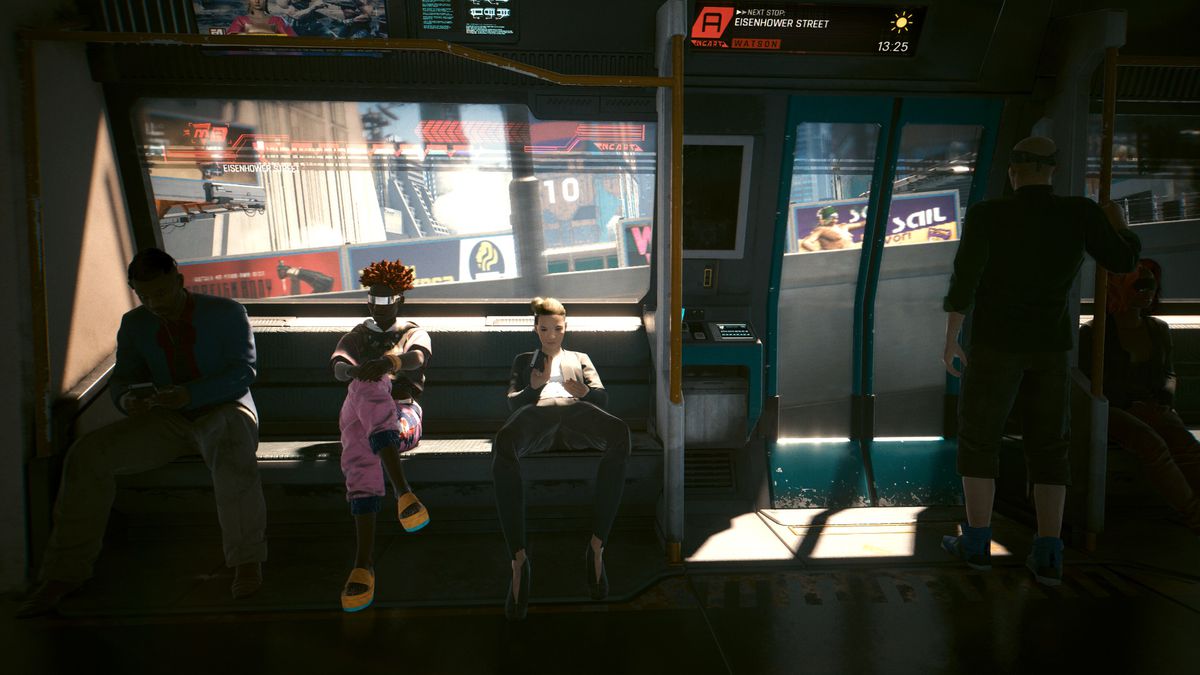Why is Cyberpunk 2077's subway so slow? An investigation
CD Project Red fulfilled a five-year promise last week when it added a fully functional subway system Cyberpunk 2077. While the feature does wonders for making Night City feel more alive, I was surprised to learn how little California's public transportation infrastructure has improved in the game's alternate reality.
Cyberpunk 2077 now includes five Night City Area Rapid Transit (NCART) rail lines serving 19 stations. Each stop still acts as a fast travel point, but players can also use them to hop on the subway and move to other parts of the city in real time. Because movement on the train is limited, this is primarily a visual experience, offering people a new perspective on the vast megacity and limited opportunities to talk to their fellow passengers.
During one ride, I noticed a screen showing that the train's speed was constantly hovering around 45 miles per hour, which felt very slow for futuristic transportation. Average speeds of modern heavy rail systems in the United States range from the teens to the mid-30s, but they can reach much higher maximums. Not to mention the more developed public transportation in Japan and China, where magnetic levitation (maglev) bullet trains zip through major cities at hundreds of miles per hour.
This ties in with what the first thing is Cyberpunk the rulebook had to say about the then transportation in 1988:
Surprise, surprise. Contrary to expectations, the year 2000 did not bring any dazzling new developments in the transport sector. Years of economic struggle and civil unrest have discouraged research into new ways of traveling – in fact, travel itself has become severely limited. Expect the world of 2013 to look a lot like the 20th century: a network of busy highways, crowded trains and teeming airports.
A subsequent expansion, Welcome to Night Cityindicates that light rail magnetic trains with a travel speed of 320 km/h already existed in the metropolis of the same name in 2013, the year in which the first Cyberpunk adventures were recorded. Every book since has mentioned maglev trains as a staple of travel to Night City, and the one from 2005 Cyberpunk V3.0 even recorded an improvement in their top speed to 300 mph (480 km/h), despite the apparent destruction of the intercontinental magnetic line during the Fourth Corporate War (which took place from 2021 to 2025 in-universe) between the world's ruling megacorps.
(And to cover my ass: 1990 updated Cyberpunk 2020 the rulebook makes it clear that NCART and the light rail maglev trains are one and the same.)
It's here that Cyberpunk 2077 does something smart by expanding the consequences of this conflict. Rather than just moving train traffic between continents, the game describes the Fourth Company War as weakening the entire maglev system, as explained by the following database entry:
Maglev trains traveled at high speeds through tunnels and over the surface thanks to the advent of electrodynamic suspension technology, allowing fast and comfortable travel from Night City to other cities including Kansas City, St. Louis, Atlanta and Washington DC. Unfortunately, this new era of transportation did not last long. The social unrest and armed conflict of the Fourth Corporate War brought an economic crisis that quickly paralyzed the entire system. The abandoned Maglev tunnels are currently non-operational and used by homeless people and various gangs.
The destruction of the maglev system and the slow NCART speeds seen in the game led me to believe that the local government was forced to revert to pre-2013 technology to ensure NCART remained operational, a huge downgrade from the bullet trains that once transported residents through the night. City and beyond.

As I researched this situation, I couldn't help but see dark, hilarious parallels between the difficulties facing fictional California depicted in Cyberpunk 2077 and the actual state in which I live.
Despite being one of the largest (both in terms of land and population) and wealthiest states in the union, California has long struggled with plans to build mass transit comparable to East Asia's high-speed rail. A lot of them do because of politics, as even seemingly supportive lawmakers are wary of spending the billions of dollars needed to complete the project. And let's face it: Americans are just way too dedicated to their cars.
That said, there's one very simple explanation for the Night City subway's relatively slow speed: the developers didn't want NCART rides to happen in the blink of an eye. What good would the long-awaited subway experience be if players didn't actually experience it?
Traveling at 300 miles per hour wouldn't give people time to look at Night City's eccentric residents or enjoy the view of the skyscrapers surrounding the bay outside the train's windows. The whole point of the subway system – and a big part of why people have been calling for its inclusion all these years – is to give players new opportunities to role-play and experience the visual splendor of the subway system. Cyberpunk 2077's setting and its exaggerated aesthetic.
I find it difficult to accuse CD Projekt Red of playing a little loose with established values Cyberpunk history if it ultimately makes for a better game.
